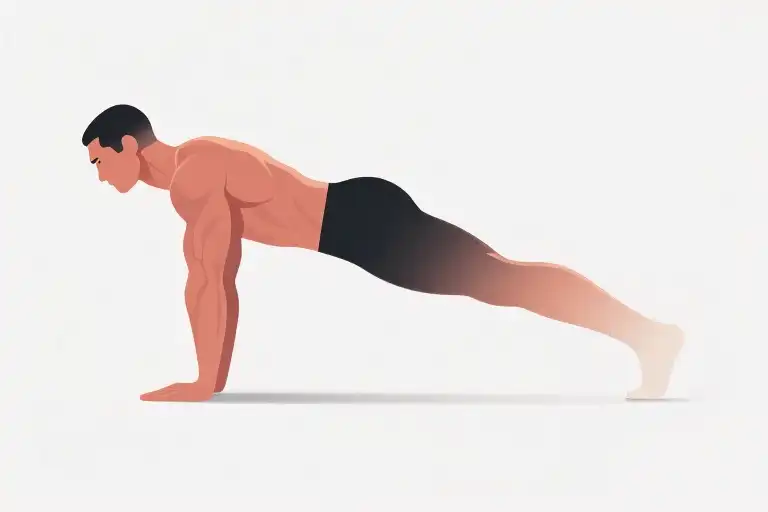There’s a peculiar truth about planking that no fitness influencer will tell you: time doesn’t just slow down when you’re in that position—it practically stops. That deceptively simple exercise where you hover parallel to the floor reveals more about temporal perception than any philosophy textbook ever could. I discovered this during my thirty-day affair with daily planks, an experiment that began as a core-strengthening mission and ended as a meditation on endurance.
Planking looks like the lazy person’s workout—no jumping, no weights, just holding still. Until you actually try it. Those first thirty seconds feel manageable, even easy. Then your abdominal muscles start sending increasingly urgent memos to your brain, your shoulders develop a sudden fascination with gravity, and what the clock claims is one minute stretches into what feels like geological time. It’s the closest most of us will come to experiencing relativity firsthand.
This personal revelation arrived during my latest thirty-day challenge, a habit I’ve adopted for everything from hydration goals to sugar detoxes. As someone who spends more time hiking mountain trails than gyms, I’ve always preferred functional fitness over aesthetic pursuits. My ideal workout involves scrambling over coastal rocks with a backpack, not counting reps under fluorescent lights. But even outdoor enthusiasts need core strength—that invisible musculature that keeps you upright during switchbacks and stable on uneven terrain. Hence the plank challenge: two minutes daily for thirty-one days (because apparently I enjoy round numbers with bonus days).
The beauty of planking lies in its brutal simplicity. No equipment beyond a patch of floor. No special clothing (though I don’t recommend doing it in a business suit). Just you, your trembling core, and the increasingly loud voice in your head negotiating early release. It’s the perfect microcosm of commitment—show up, hold on, repeat. And like most worthwhile challenges, the real transformation happens not in the body first, but in the mind. That moment when every muscle begs for mercy and you choose to stay anyway? That’s where the magic lives.
What began as physical training quickly became mental conditioning. There’s something profoundly grounding about an exercise that literally connects you to the floor while demanding you resist its pull. In our accelerated world of endless scrolling and multitasking, planking forces singular focus. You can’t plank while checking emails. You can’t half-plank. It’s all or nothing—a refreshing antidote to our culture of partial attention.
My relationship with the plank evolved through distinct phases, much like grief but with more sweat. Initial optimism gave way to bargaining (“Surely forty-five seconds counts?”), then resigned acceptance, and finally—somewhere around day eighteen—something resembling enjoyment. Not of the sensation itself, but of the daily proof that discipline compounds. That two minutes which initially felt impossible became merely difficult, then manageable, then—dare I say—routine. The body adapts when given consistent challenges, a lesson that transcends fitness.
This thirty-day experiment wasn’t about achieving Instagram-worthy form or chasing unrealistic body standards. It was about testing incremental progress, about showing up even when—especially when—every fiber protests. Because if you can commit to two minutes of voluntary discomfort daily, what else might you be capable of? The plank doesn’t just strengthen your core; it fortifies your resolve. And in a world full of distractions and quick fixes, that might be the most valuable muscle of all.
Why Plank? More Than Just a ‘Core’ Fad
That deceptively simple position where you balance on your elbows and toes? It’s not just another fitness trend. What feels like an eternity when you’re in it actually delivers real-world benefits that extend far beyond gym bragging rights. As someone who spends weekends scrambling up mountain trails, I discovered how foundational strength literally supports every step.
Core muscles aren’t just about aesthetics – they’re the body’s natural corset. A study in the Journal of Strength and Conditioning Research found that regular planking activates 20% more deep abdominal fibers than traditional crunches. This matters when you’re carrying a backpack uphill or sitting through back-to-back Zoom meetings. Those muscles act as stabilizers, preventing the slouch that leads to 3pm energy crashes.
What surprised me most wasn’t the physical transformation (though holding a plank for 2 minutes without collapsing felt like winning gold). It was how this simple exercise improved things I never expected:
- Hiking endurance: No more wobbling on uneven terrain after the first hour
- Posture reset: My shoulders stopped inching toward my ears during work stress
- Breath control: Deeper diaphragmatic breathing that carries me through tough moments
Neurologists might explain the time distortion effect during planking through our brain’s pain-processing mechanisms. But I prefer the practical interpretation: when your entire body engages simultaneously, there’s no mental bandwidth left to watch the clock. Thirty seconds of full-body tension teaches presence better than any meditation app.
The beauty of a 30-day plank challenge lies in its brutal honesty. Unlike vague “get stronger” goals, the stopwatch doesn’t lie. You’ll know exactly when your form falters because suddenly holding position becomes impossible. This immediate feedback creates what behavioral scientists call “small wins” – measurable progress that fuels motivation. My Week 1 struggle to hit 45 seconds made the eventual 2-minute milestone feel like summiting a personal Everest.
Before you dismiss this as another fitness fad, consider the alternative. We spend approximately 1,200 hours annually sitting – a posture that weakens those crucial core muscles. Just two daily minutes of planking counterbalances about sixteen hours of chair time. It’s not about sculpting magazine-cover abs; it’s about rebuilding what modern life erodes.
Next time you feel time slipping through your fingers, drop into a plank. Those agonizing seconds where muscles tremble and focus narrows? That’s where real strength – both physical and mental – gets forged. Not in dramatic transformations, but in daily showing up for two minutes that change how you move through all the other minutes of your life.
The 30-Day Survival Guide: From Groaning to Glory
Let’s be honest – that first 30-second plank on Day 1 will feel eternal. Your elbows will dig into the mat, your shoulders will tremble, and somewhere around the 15-second mark, your brain will start negotiating: “Maybe 25 seconds counts as 30?” I know because I’ve been there. But here’s the blueprint that took me from barely surviving half a minute to comfortably holding a 2-minute plank.
Week 1: The Awkward Introduction (30-60 seconds)
During these initial seven days, your body is learning what “core engagement” actually means. Most beginners make two critical mistakes: letting their hips sag (which strains the lower back) or hiking their buttocks too high (cheating the core work). The magic fix? Imagine squeezing a walnut between your belly button and spine – that subtle contraction is what protects your back while working the right muscles.
Pro tip: Set up near a mirror to check your form:
- Elbows directly under shoulders
- Body forming straight line from head to heels
- Abdominals engaged (not holding breath)
Week 2: Finding Your Rhythm (60-90 seconds)
This is when most people quit. The novelty wears off, and muscles start protesting. My breakthrough came when I stopped watching the clock and focused on breathing:
- Inhale deeply through nose (4 counts)
- Exhale fully through pursed lips (6 counts)
This oxygen flow does double duty – it distracts from the burn and prevents the dizziness some experience. If your form starts collapsing before reaching the minute mark, drop to your knees (see “Modifications” below) rather than compromising posture.
Week 3: The Turning Point (90-120 seconds)
Around Day 18, something clicks. Those previously ignored stabilizing muscles begin cooperating. You’ll notice:
- Less shaking during household activities (like reaching for top shelves)
- Improved posture at your desk
- That satisfying “whole-body tension” feeling during the plank
Now’s the time to experiment with subtle variations:
- Squeeze glutes tighter to protect lower back
- Gently draw shoulder blades together to engage upper back
- Rotate palms upward to reduce wrist pressure
Week 4: Owning the Two-Minute Mark
By this stage, the challenge becomes more mental than physical. Try these psychological tricks:
- Break the time into chunks: “Just 30 more seconds” four times
- Visualize your core as a corset tightening around your torso
- Count backward from 100 – the concentration required alters time perception
Common Form Pitfalls (And How to Fix Them)
- The Saggy Middle
- Symptom: Lower back aches during/after
- Fix: Tuck pelvis slightly, engage lower abs
- The Tent Pose
- Symptom: Butt sticks up like a camping tent
- Fix: Have a friend place a broomstick along your spine – only head, upper back and heels should touch
- The Neck Crane
- Symptom: Staring straight ahead strains cervical spine
- Fix: Gaze at floor about a foot beyond hands
When Your Body Says “No”: Smart Modifications
For those days when fatigue or discomfort hits:
- Knee Plank: Reduces load by ~40% while maintaining core engagement
- Forearm Plank with Knees Down: Ideal for wrist-sensitive individuals
- Incline Plank: Hands on elevated surface (bench/stairs) decreases difficulty
Remember: A modified plank done with perfect form beats a full plank with compromised alignment. The goal isn’t suffering – it’s sustainable strength building.
The Equipment-Free Advantage
One beautiful aspect of the 30 day plank challenge? Zero gear required. I’ve done planks in hotel rooms, airport lounges, and even once discreetly behind a sand dune during a beach picnic (don’t ask). All you need is:
- 2m² of floor space
- A timer (phone works)
- Optional: Yoga mat for elbow comfort
This accessibility makes it the perfect easy fitness challenge for travelers, busy parents, or anyone resisting gym memberships.
Troubleshooting the Tough Days
Even with this blueprint, you’ll encounter days when motivation lags. Here’s what got me through:
- The 10-Second Rule: Commit to just 10 seconds – usually, you’ll continue once started
- Pairing Habit: Attach planking to an existing routine (e.g., after brushing teeth)
- Progress Photos: Weekly side-view shots reveal subtle posture improvements
What surprised me most wasn’t the physical transformation (though my hiking backpack did feel lighter). It was realizing that holding a plank for 2 minutes became less about strength and more about breath control and mental focus – skills that translated unexpectedly well to stressful workdays.
Next up: The tangible results (and surprising side benefits) that kept me continuing beyond the 31 days…
What 31 Days of Planking Did to My Body (Spoiler: No Six-Pack)
Let’s get one thing straight upfront: thirty-one days of planking didn’t magically carve out a six-pack. What it did deliver was far more practical – the kind of changes you feel before you see.
The Numbers Don’t Lie
| Day Range | Average Hold Time | Subjective Difficulty (1-10) |
|---|---|---|
| 1-7 | 45 seconds | 7 |
| 8-14 | 1 min 15 sec | 6 |
| 15-21 | 1 min 45 sec | 5 |
| 22-31 | 2 min+ | 4 |
That progression tells its own story. Those first seven days were brutal – every second past thirty felt like an eternity. By week three though, something shifted. My body stopped fighting the position and started working with it.
The Phases of Plank Acceptance
- The Tremble Phase (Days 1-10)
Your body’s initial reaction is pure betrayal. Shoulders quiver, core muscles you forgot existed start sending angry memos. The timer becomes your nemesis. - The Negotiation Phase (Days 11-20)
You discover little tricks – focusing on your breathing pattern, mentally dividing the time into chunks. The burn’s still there, but it’s a familiar discomfort now. - The Flow Phase (Days 21-31)
Suddenly you’re not white-knuckling through it anymore. There’s rhythm to your holds, and that last push to two minutes feels challenging but achievable.
The Unexpected Perks
Beyond the core strength gains, three surprises emerged:
- Hiking Upgrade: Those rocky trails I love? Found myself navigating them with new stability. The connection between plank endurance and real-world balance became obvious.
- Posture Payoff: Without consciously trying, I caught myself sitting taller at my desk. That subtle engagement of core muscles started happening automatically.
- Sleep Bonus: Falling asleep came easier on plank days. Whether from physical fatigue or the mental discipline, I’d drift off faster.
Here’s the honest truth about visible changes: my waist didn’t dramatically shrink, but my jeans fit differently. Not looser exactly, but better. Like my body had rearranged itself slightly.
The real victory wasn’t in the mirror – it was in ordinary moments. Carrying groceries without lower back protest. Getting up from the floor without using my hands. Those small wins added up to something substantial.
Would I do it again? Absolutely. Not for aesthetics, but for that quiet confidence that comes from showing up for yourself daily. Two minutes is nothing… until you try holding them in perfect plank form. Then it becomes everything.
Your Turn! The Lazy Person’s Starter Kit
Let’s be honest – most fitness plans fail because they’re too complicated. That’s why this 30-day plank challenge comes with what I call the “lazy person’s guarantee”: if you can spare two minutes a day (yes, even during Netflix binges), you can do this. Here’s everything you need to get started without the usual overwhelm.
The Foolproof Tracking System
I used three sticky notes on my bathroom mirror:
- Day 1-10: “Just show up” (seriously, just get in position)
- Day 11-20: “Breathe through it” (inhale through nose, exhale through mouth)
- Day 21-30: “Own it” (that glorious moment when your body stops protesting)
For those who prefer digital tools, set a recurring daily alarm titled “Plank Party” – the sillier the name, the harder it is to ignore.
The Modified Starter Pack
Not all days are created equal. When life hits hard:
- Knee Plank: Reduces load by 40% but keeps core engaged
- Forearm Plank Against Wall: Takes pressure off wrists
- The Coffee Break Version: 3x 20-second holds spread through the day
Safety Checks (Read This Before Starting)
- Stop immediately if: You feel sharp lower back pain (not to be confused with normal muscle fatigue)
- Form reminders:
- Keep elbows directly under shoulders
- Imagine holding a marble between your shoulder blades
- Engage glutes to protect lumbar spine
- When to skip: Fever, acute back injury, or after heavy meals (trust me on that last one)
Answering Your Probable Questions
- “Can I split the 2 minutes?” → Absolutely! Try 4x 30-second sessions
- “What time of day?” → Whenever you’re least likely to bail (mornings worked best for me)
- “My arms give out first!” → Shift weight slightly back toward heels
Join the (Very Casual) Movement
Tag #30DayPlankChallenge on Instagram with:
- Your “plank face” (we all make one)
- Creative planking locations (I once did mine at a wedding reception)
- Progress notes (“Day 12: Discovered new abdominal muscles… they’re angry”)
Remember: This isn’t about perfection. My Day 3 involved collapsing after 45 seconds while cursing. By Day 30? I could hold conversation during the full 2 minutes (mostly complaining, but still). Your core won’t transform overnight, but your belief in small daily actions will.
Final tip: Place your yoga mat somewhere unavoidable – mine lived between my bed and bathroom. Time may fly, but your core won’t lie about those two minutes.
Time May Fly, But Your Core Won’t Lie
Thirty-one days. Two minutes per day. That’s all it took to prove that small, consistent actions create tangible change. When I began this 30 day plank challenge, holding a proper plank for more than 30 seconds felt like an eternity. By the end? Those same two minutes became my daily meditation—a quiet battle between mind and muscle where time finally slowed down.
The Beauty of Micro-Commitments
This experiment reinforced something vital: fitness transformations don’t require heroic efforts. No gym memberships, no expensive equipment, just a patch of floor and the willingness to show up daily. The plank benefits for core strength quietly ripple outward—better posture during long hikes, less lower-back stiffness after hours at my desk, and an unexpected bonus: deeper sleep. Not bad for an exercise that looks deceptively like “just hovering.”
For anyone skeptical about beginner plank progression, my before-and-after metrics tell the story:
- Day 1: 30 seconds (collapsed in a heap)
- Day 15: 1 minute 10 seconds (muscles finally stopped screaming)
- Day 31: 2 minutes 5 seconds (steady breathing, engaged core)
The real victory wasn’t the extra seconds—it was realizing how much strength had been hiding beneath the surface all along.
Your Turn: The Lazy Person’s Toolkit
- Start stupid small: Begin with 20-second planks if needed. Consistency trumps duration.
- Pair it with a habit: Do it right after brushing your teeth or pouring morning coffee.
- Celebrate the wobbles: Those shaky moments? That’s your body rewriting its limits.
No need to chase six-pack abs or gym selfies. This is about something far more radical: proving to yourself that you’re capable of more than you assume. Print a calendar, mark each completed day with a bold X, and watch how quickly “I can’t” becomes “I did.”
Parting Thought
Health isn’t built in grand gestures, but in the accumulation of unremarkable moments—like those daily two minutes where you choose to stay. As for time? It still flies. But now, when it does, you’ll be flying with a stronger foundation.
“Time may fly, but your core won’t lie.”





